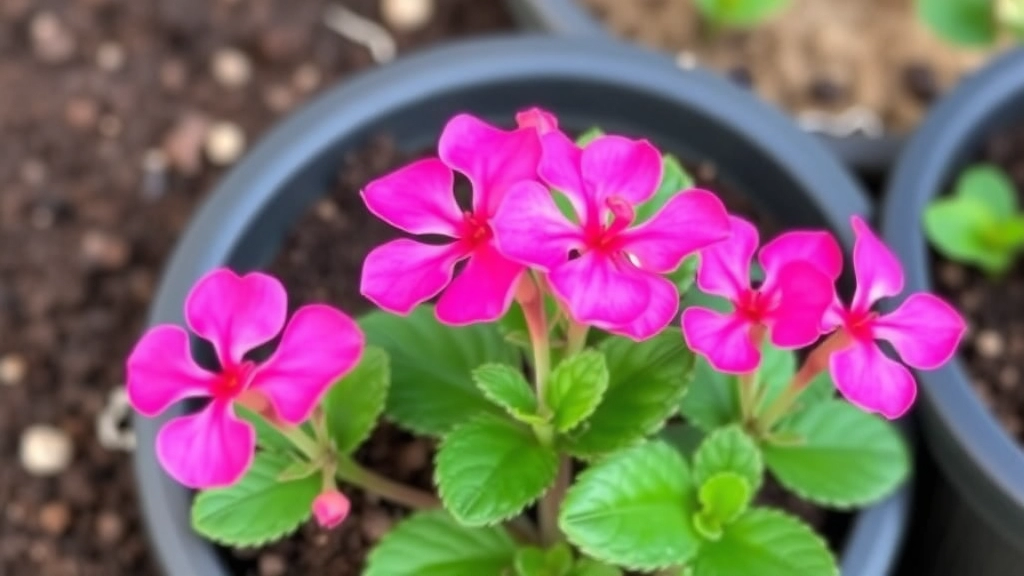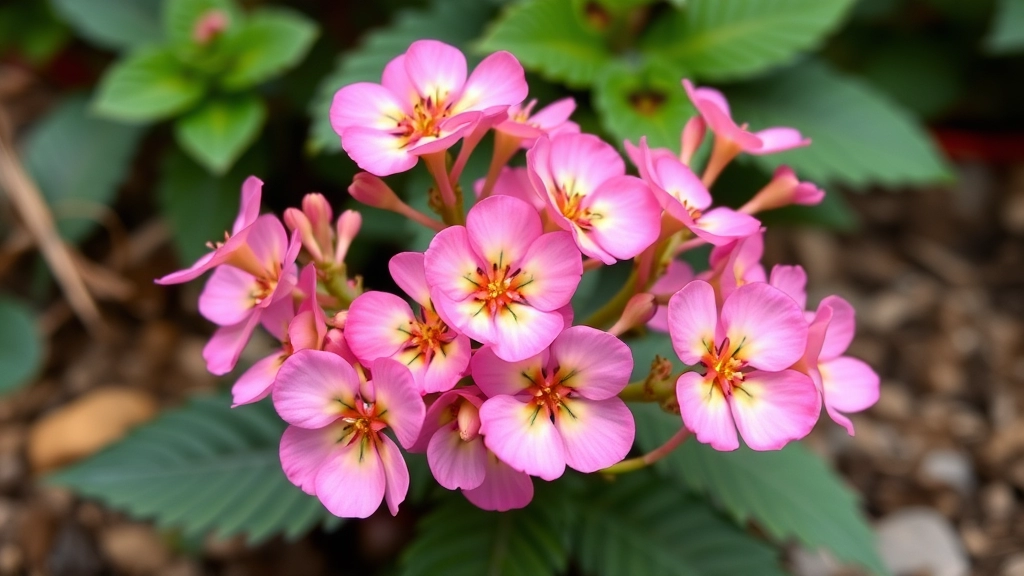Pink Butterflies Kalanchoe: The Mother of Thousands
Have you ever laid eyes on the mesmerizing Pink Butterflies Kalanchoe, also known as the Mother of Thousands? This unique succulent is a showstopper with its delicate pink plantlets that cascade down its leaves. Whether you’re a seasoned plant parent or a newbie, this guide will help you understand everything there is to know about caring for and propagating this stunning plant.
From its key characteristics to optimal soil and potting conditions, we’ll dive into the essentials of keeping your Pink Butterflies Kalanchoe thriving. We’ll also cover watering needs, light and temperature preferences, and common mistakes to avoid. Ready to turn your home into a succulent haven? Let’s get started!
Are you considering adding Kalanchoe ‘Pink Butterflies’ to your collection? This stunning succulent is not just visually appealing but also boasts unique features that make it a favourite among plant enthusiasts.
Kalanchoe ‘Pink Butterflies’ is renowned for its vibrant, butterfly-shaped leaves that transition from green to a lovely pink hue, especially when exposed to bright light.
Key Features:
– **Leaf Shape**: The leaves are thick and fleshy, resembling butterfly wings.
– **Colouration**: The pink edges develop more prominently under optimal light conditions.
– **Height**: Typically grows to about 30-45 cm, making it suitable for both indoor and outdoor settings.
– **Flowers**: When in bloom, it produces clusters of small, tubular flowers that add an extra pop of colour.
This plant is also known for its resilience, making it an excellent choice for both novice and experienced gardeners. For more detailed care instructions, you can refer to the [complete guide to growing and caring for Kalanchoe ‘Pink Butterflies’](https://planthq.org/complete-guide-to-growing-and-caring-for-kalanchoe-pink-butterflies/).
Additionally, if you’re interested in exploring other vibrant varieties, check out the [top Kalanchoe varieties with pink edges](https://planthq.org/top-kalanchoe-varieties-with-pink-edges/).
Optimal Soil and Potting Conditions for Kalanchoe ‘Pink Butterflies’

So, you’ve got your Kalanchoe ‘Pink Butterflies’ and you’re wondering about the best soil and potting conditions, right?
Choosing the right soil is crucial for this succulent.
Soil Type
- Well-draining soil is a must.
- Look for a cactus or succulent mix.
- You can also create your own by mixing regular potting soil with perlite or sand.
This will help prevent root rot, which is a common issue for Kalanchoe.
Potting Tips
- Choose a pot with drainage holes. This allows excess water to escape, keeping the roots happy.
- When repotting, make sure the new pot is only slightly larger than the previous one. This helps manage moisture levels.
Fertilising
- Fertilise lightly during the growing season with a balanced, diluted fertiliser.
- Too much can harm your plant, so stick to the label instructions.
Additional Considerations
- If you’re in a colder climate, consider using a terracotta pot. It helps regulate temperature and moisture.
Watering Needs and Common Mistakes to Avoid
Understanding the watering needs of Kalanchoe ‘Pink Butterflies’ is crucial for its thriving growth. Many plant enthusiasts often grapple with how much water to provide, leading to either overwatering or underwatering.
Light and Temperature Preferences

When caring for Kalanchoe ‘Pink Butterflies’, understanding its light and temperature preferences is crucial for its growth and vibrancy.
Light Requirements
Kalanchoe ‘Pink Butterflies’ thrives in bright, indirect sunlight. Here’s what you should consider:
- Optimal Light Exposure: Aim for 6 hours of bright, indirect sunlight daily.
- Avoid Direct Sunlight: Direct sun can scorch the leaves, leading to unsightly brown patches.
- Signs of Insufficient Light: If your plant starts to stretch or its leaves become pale, it’s likely not getting enough light.
Temperature Preferences
Temperature plays a significant role in the health of your Kalanchoe. Here are some guidelines:
- Ideal Range: 15°C to 25°C (59°F to 77°F) is the sweet spot for this succulent.
- Cold Sensitivity: Protect your plant from temperatures below 10°C (50°F) as it can lead to stress and damage.
- Heat Considerations: While Kalanchoe can handle warmer conditions, ensure it’s not exposed to extreme heat or drafts.
Propagation Methods: Bulbils, Leaf, and Stem Cuttings
Are you looking to expand your collection of Kalanchoe ‘Pink Butterflies’? Propagation is a rewarding way to do just that.
This succulent can be propagated through several methods: bulbils, leaf cuttings, and stem cuttings. Let’s break down each method to make it easy for you.
1. Bulbils
- What are Bulbils? Bulbils are small plantlets that form on the edges of mature leaves.
- How to Propagate:
- Gently remove the bulbils once they are a few inches long.
- Allow them to dry for a couple of days to prevent rot.
- Plant them in well-draining soil.
- Tips:
- Ensure the bulbils have roots before planting.
- Keep the soil slightly moist but not soggy.
2. Leaf Cuttings
- Why Leaf Cuttings? This method is simple and effective, making it a popular choice.
- How to Propagate:
- Select a healthy leaf and cut it cleanly at the base.
- Allow the cut edge to callous for a few days.
- Place the leaf on well-draining soil, ensuring the cut edge is in contact with the soil.
- Tips:
- Mist the soil lightly to maintain moisture.
- Be patient, as roots can take several weeks to develop.
3. Stem Cuttings
- Why Stem Cuttings? This method can yield quicker results compared to leaf cuttings.
- How to Propagate:
- Cut a healthy stem, ideally 4-6 inches long.
- Remove the lower leaves to expose the stem.
- Allow the cut end to dry for a day or two.
- Plant the stem in well-draining soil.
- Tips:
- Water sparingly until roots establish.
- Keep the cutting in a warm, bright location.
For more detailed information on growing Kalanchoe ‘Pink Butterflies’, check out our Complete Guide to Growing and Caring for Kalanchoe ‘Pink Butterflies’. Additionally, if you’re interested in exploring other varieties, don’t miss our Types of Kalanchoe Tomentosa: Varieties and Care Tips.
FAQs for Kalanchoe ‘Pink Butterflies’
What type of soil is best for Kalanchoe ‘Pink Butterflies’?
Kalanchoe ‘Pink Butterflies’ thrives in well-draining soil. You can use a cactus or succulent mix, or create your own by mixing regular potting soil with perlite or sand.
What kind of pot should I use?
Choose a pot with drainage holes to allow excess water to escape. When repotting, select a pot that is only slightly larger than the previous one to help manage moisture levels.
How often should I fertilise my Kalanchoe ‘Pink Butterflies’?
Fertilise lightly during the growing season with a balanced, diluted fertiliser. Be careful not to over-fertilise, as too much can harm the plant. Always follow the label instructions.
What are the light requirements for Kalanchoe ‘Pink Butterflies’?
This plant thrives in bright, indirect sunlight. Aim for 6 hours of bright, indirect sunlight daily. Avoid direct sunlight, as it can scorch the leaves.
What should I do if my Kalanchoe ‘Pink Butterflies’ isn’t getting enough light?
If your plant starts to stretch or its leaves become pale, it’s likely not getting enough light. Consider moving it to a brighter location.
What are the ideal temperature conditions for Kalanchoe ‘Pink Butterflies’?
The ideal temperature range is between 15°C to 25°C (59°F to 77°F). Protect your plant from temperatures below 10°C (50°F) and avoid exposing it to extreme heat or drafts.
Any additional potting considerations for colder climates?
If you’re in a colder climate, consider using a terracotta pot. It helps regulate temperature and moisture, providing a more stable environment for your plant.
References
-
The Spruce: Growing Kalanchoe Indoors
-
Gardening Know How: Kalanchoe Care
-
Old Farmer’s Almanac: Kalanchoe
